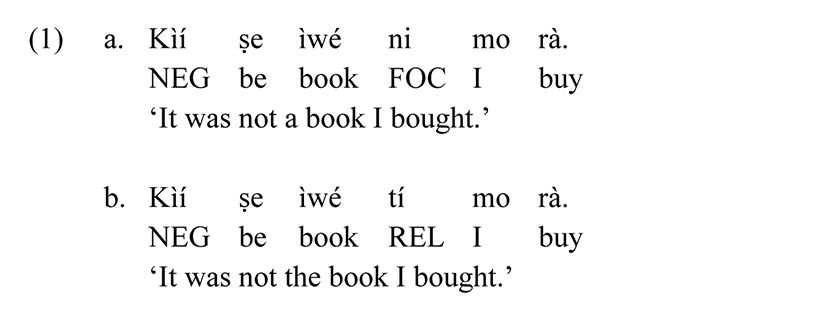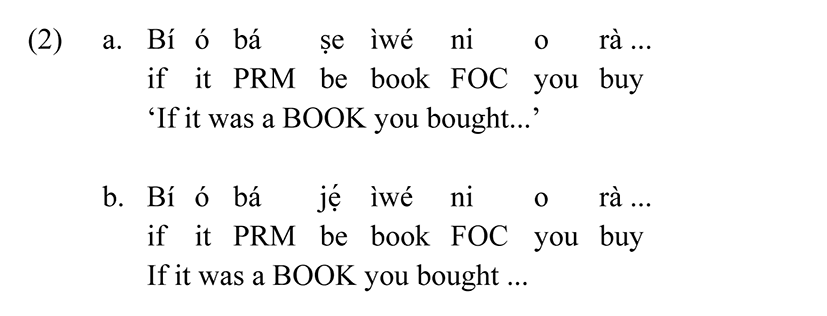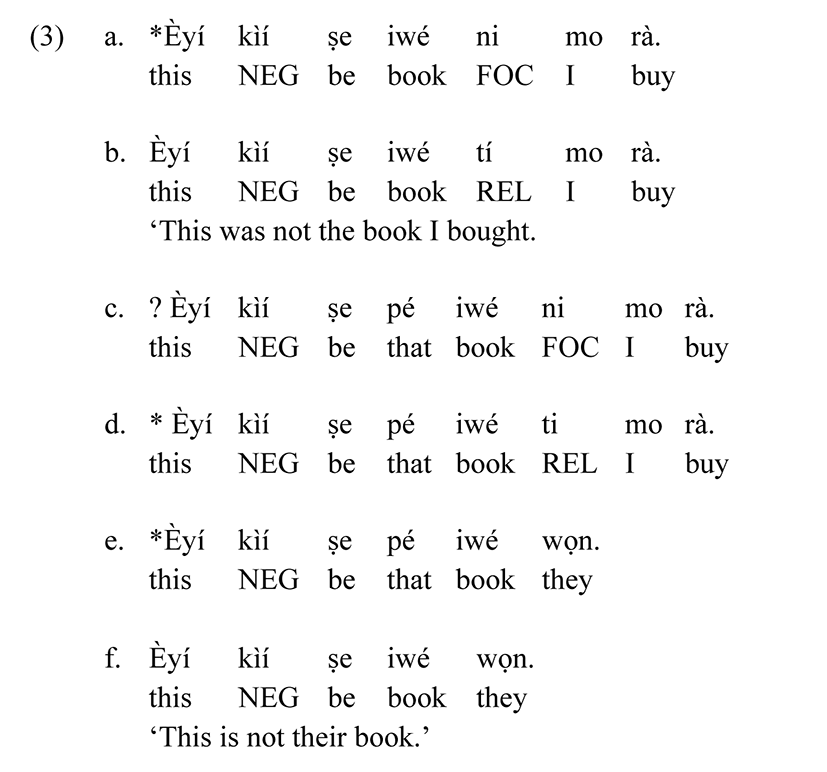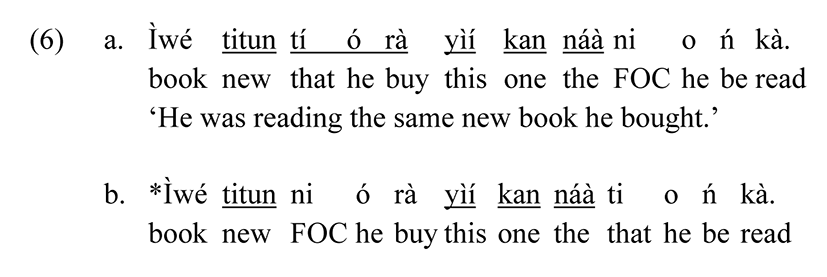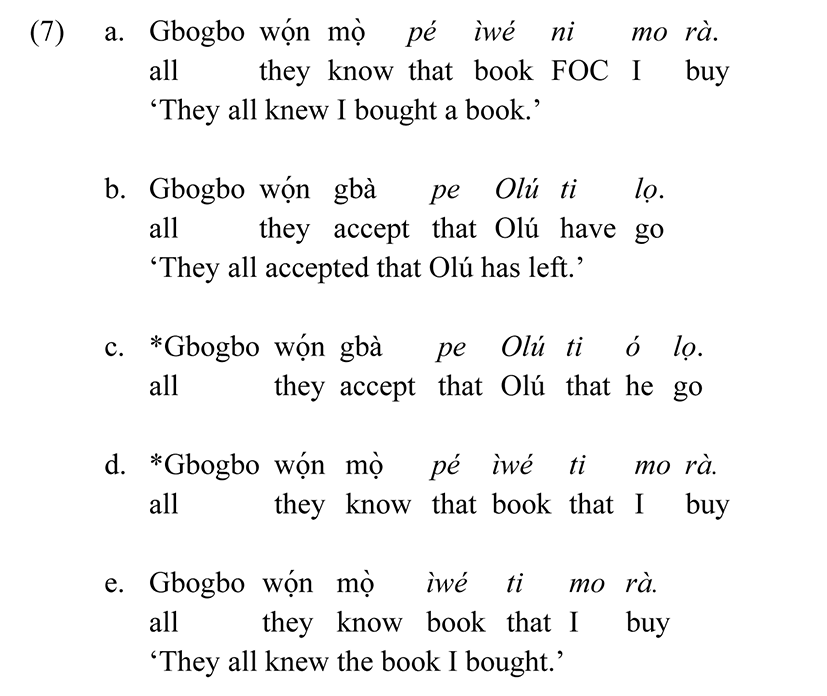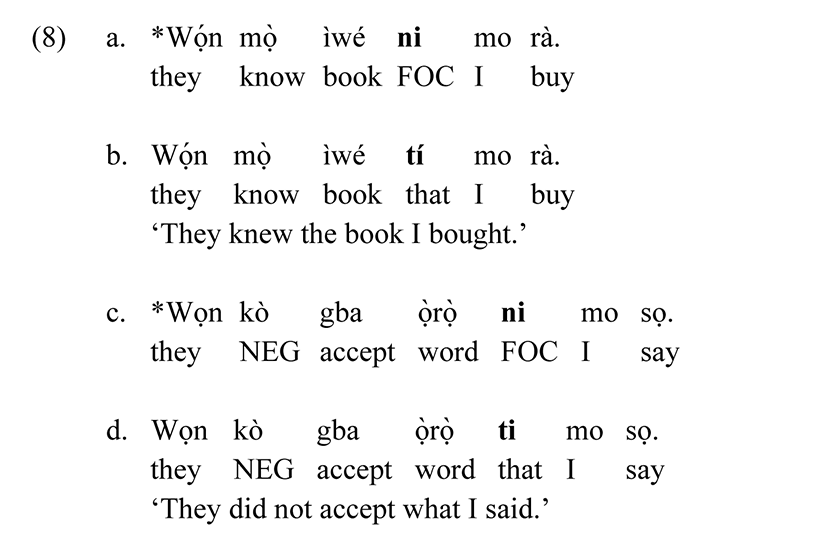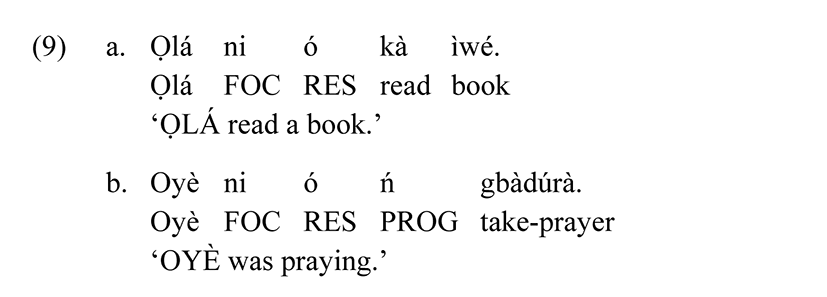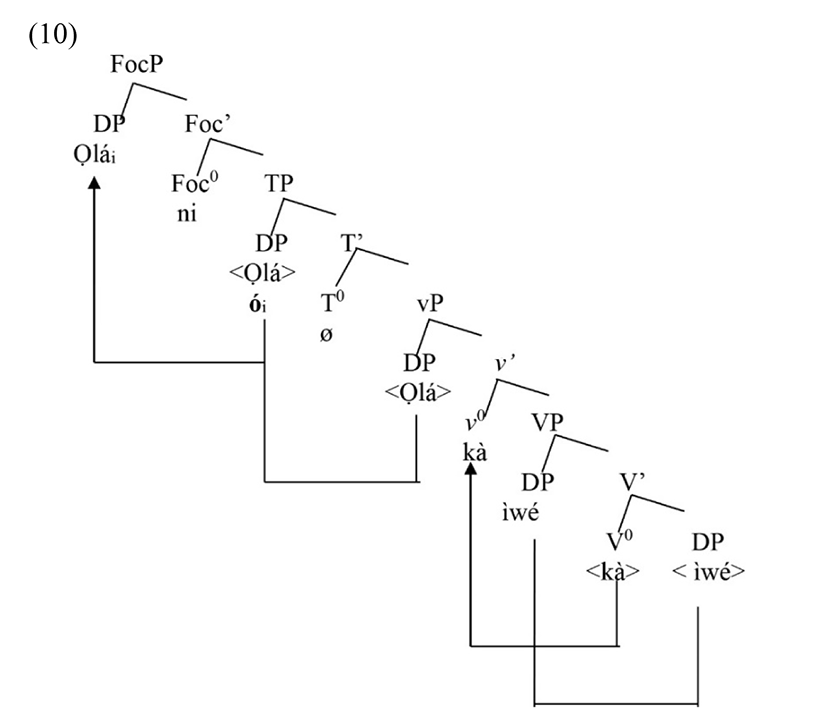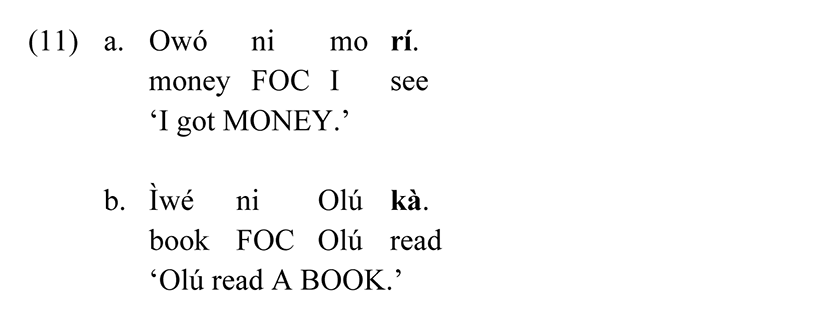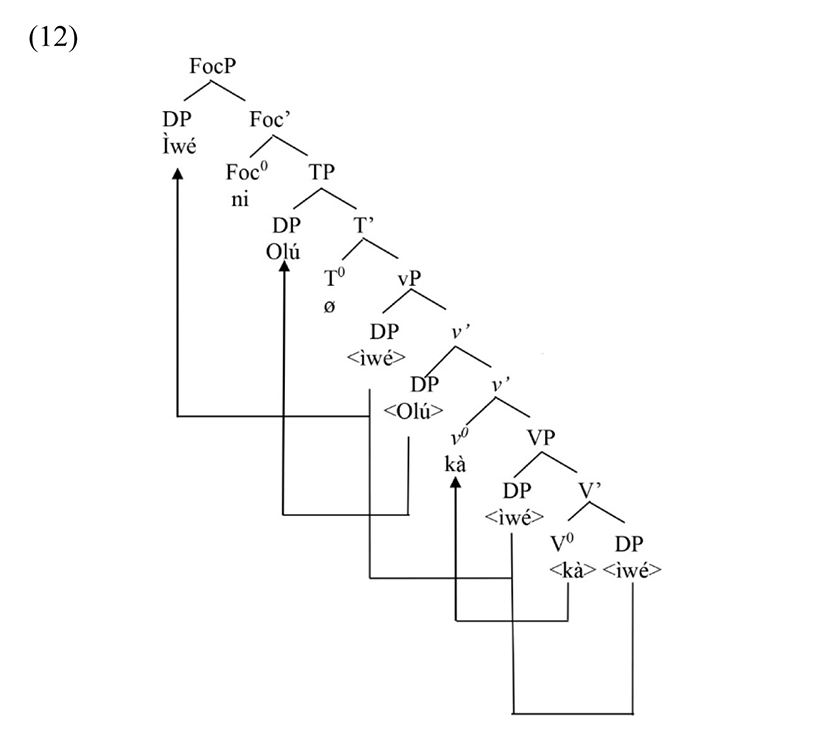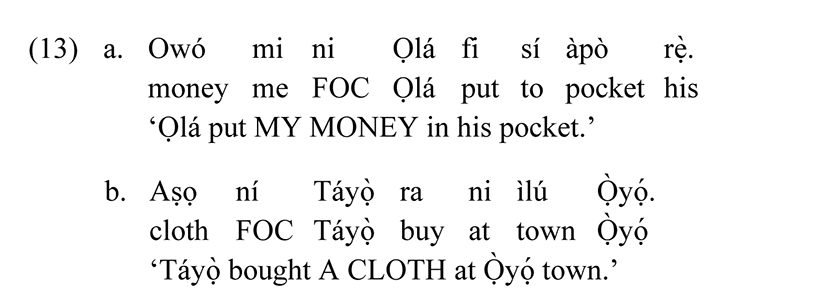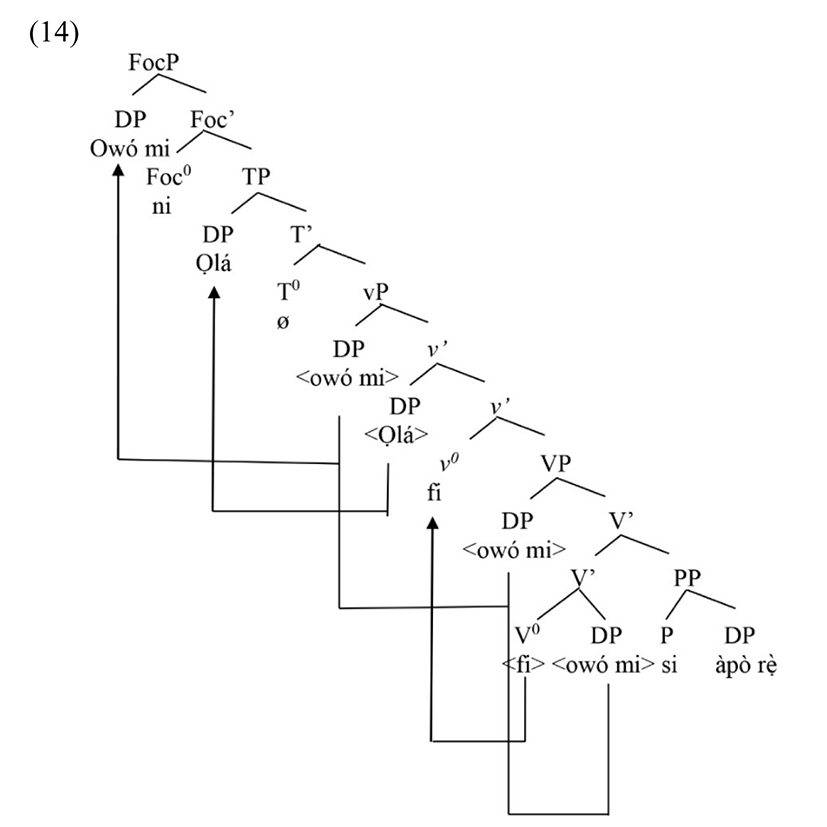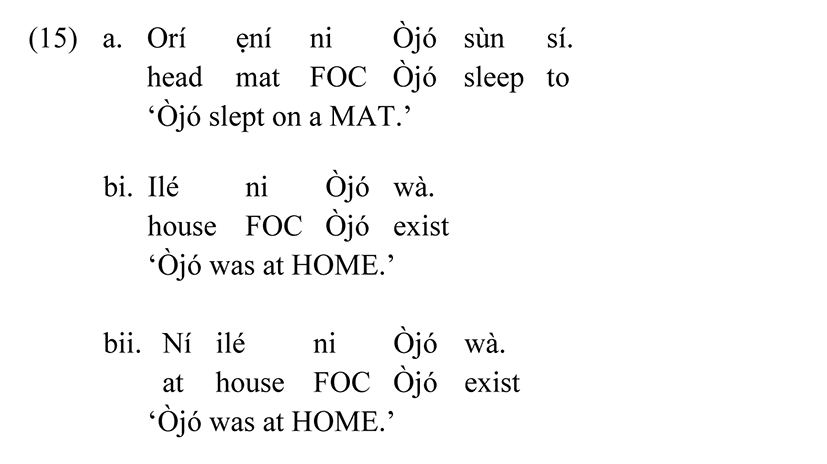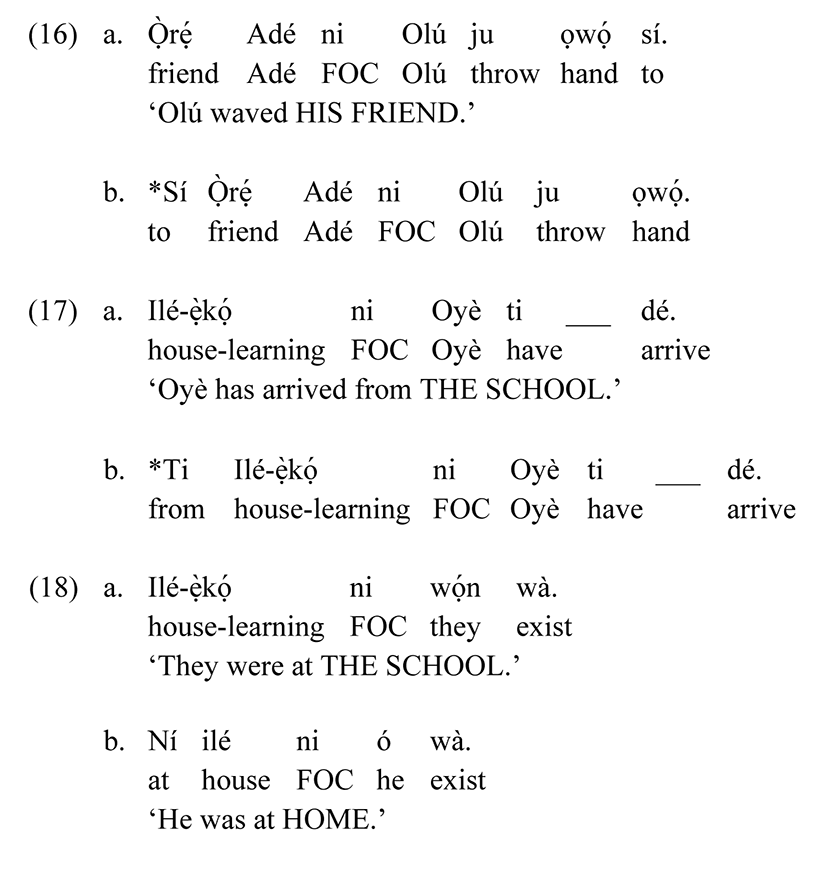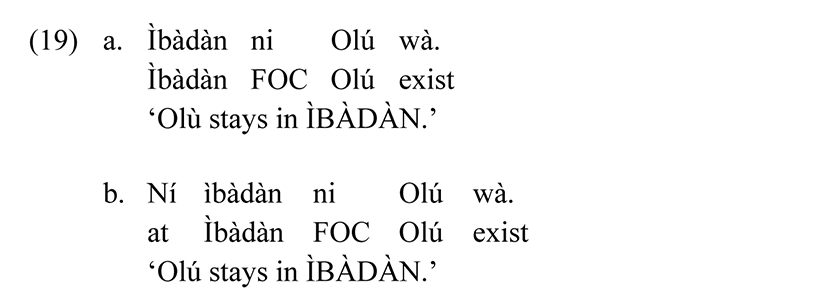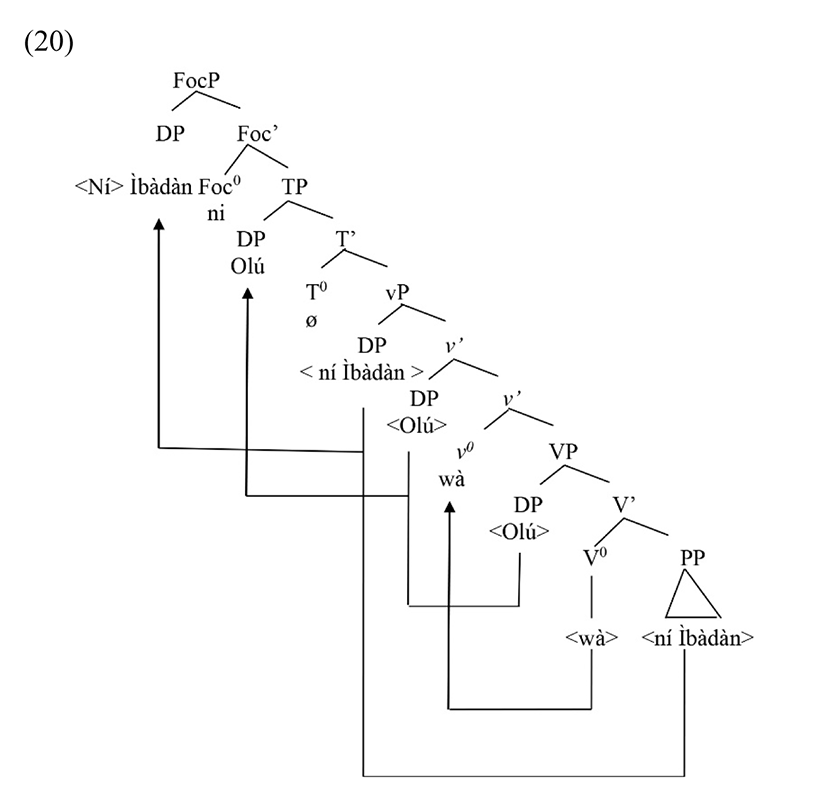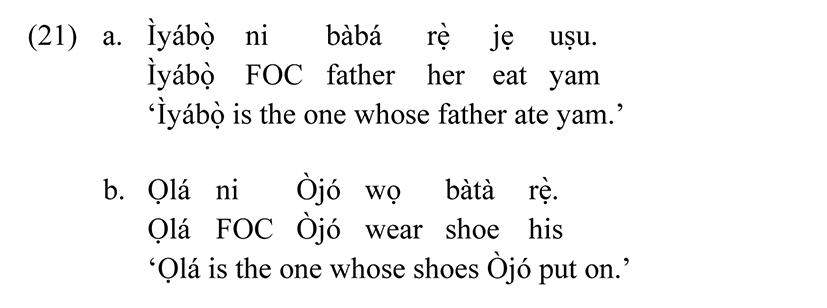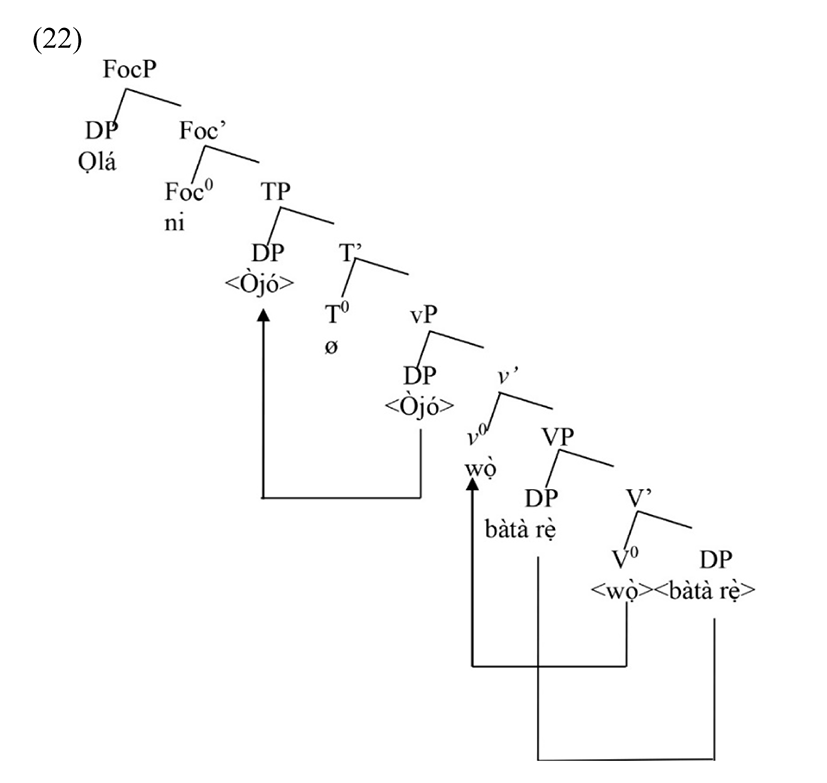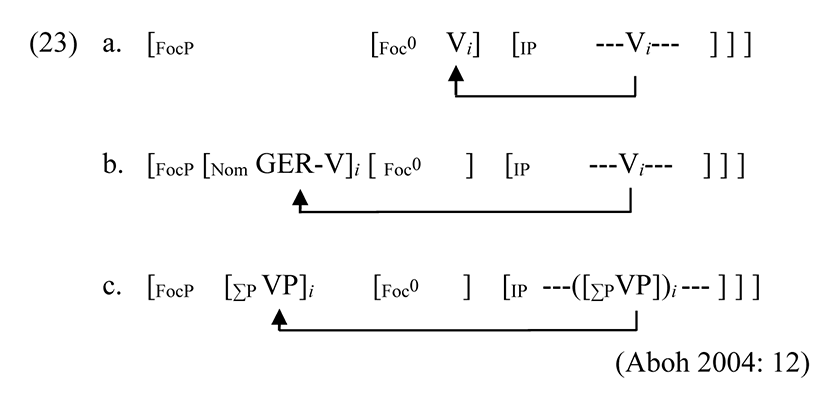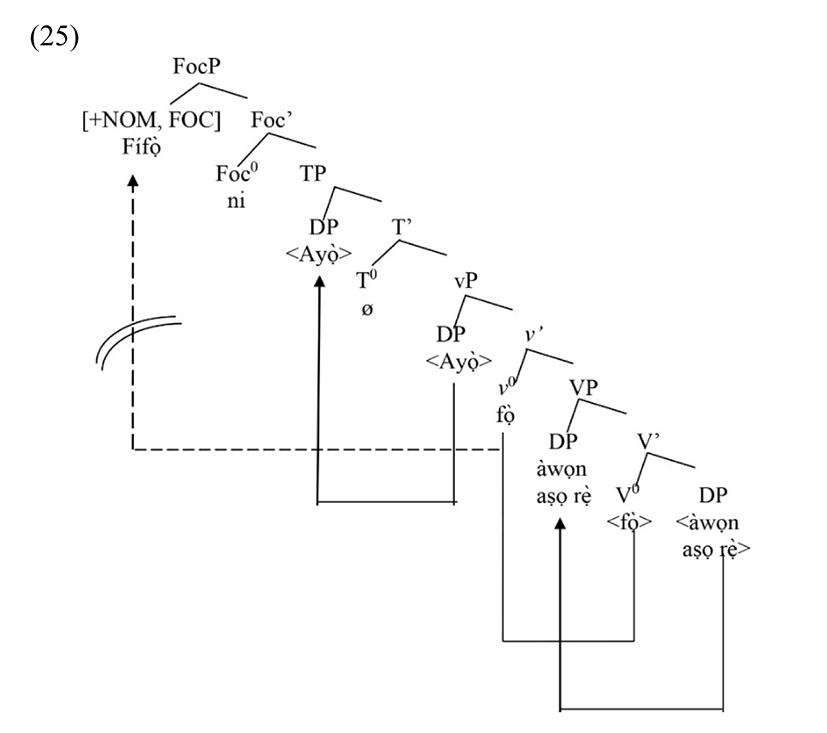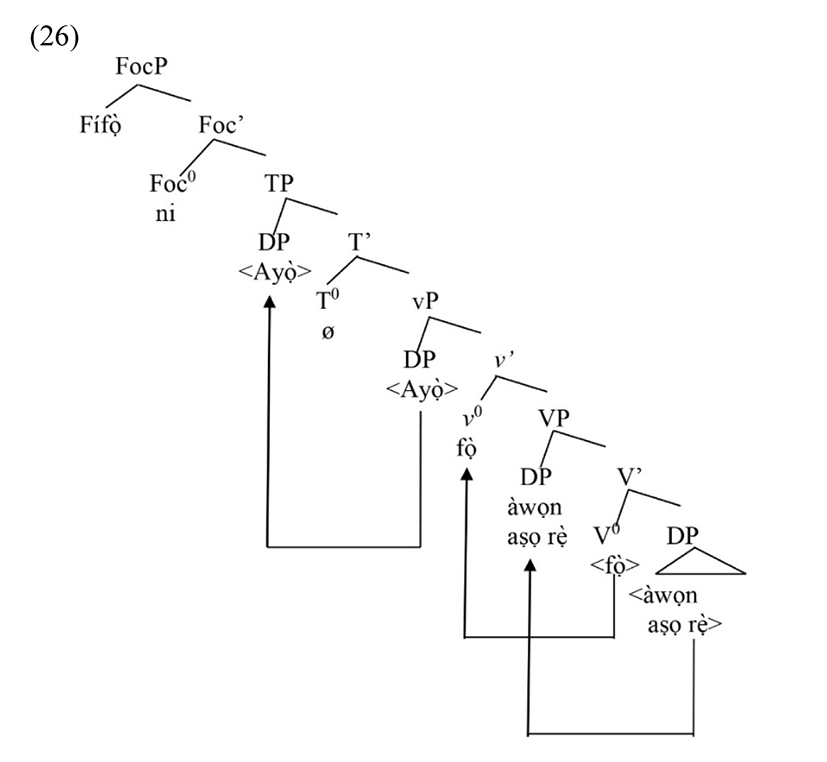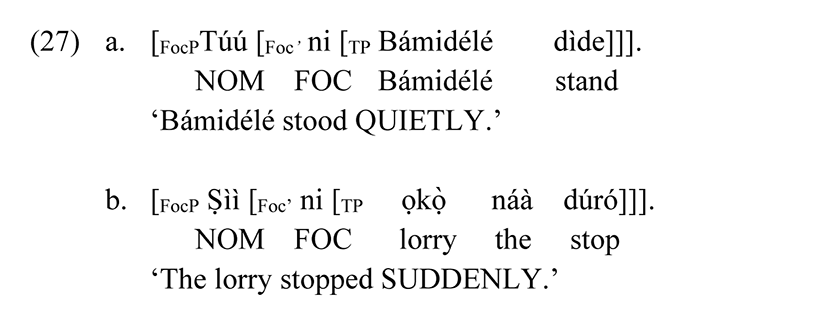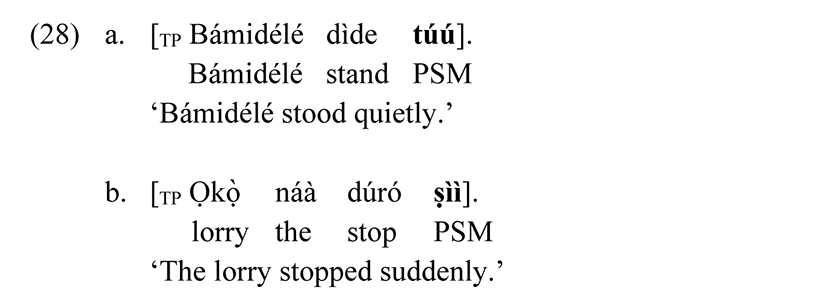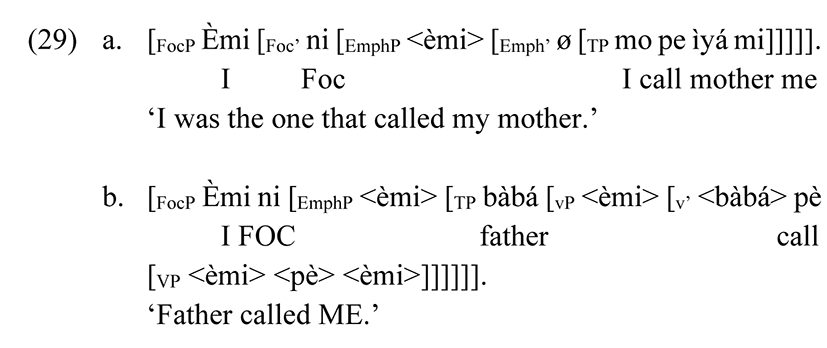1. Introduction
Focus refers to the part of a clause which provides the most relevant or salient information in a given discourse situation. It consists of the new information at the centre of a discourse (Crystal 1980). Jones (2006) refers to focus as a grammatical way of marking the organisation of information in a discourse. According to her, focus is not abstract. Languages can mark focus syntactically, prosodically and morphologically, or use the combination of these grammatical means. To her, Yorùbá focus does not trigger existence presuppositions, and it does not have obligatory exhaustivity effects. Expression of focus, according to Gussenhoven (2007), reflects three linguistic devices: one, syntax; this has to do with the position of the focus constituent in a syntactic structure and the focus particle; two, morphology; under this, we have affixation; three, phonology; this has to do with the presence of pitch, type of pitch accent and prosodic phrasing. Following Carlos’ view above, Yorùbá operates syntactic strategy to form its focus constructions. Movement is feature-driven in MP1, therefore, the strong feature on the Foc-head F0 triggers the movement of the constituent bearing a focus feature from within the vP domain to the spec FocP where it subsequently has its features checked through specifier and head agreement (Schwars 2007).
Based on the functions that focus constructions are employed for, they can be classified into identificational focus, information focus and contrastive focus (Arókoyọ̀ 2013, Ọláògún 2016, Ọláńrewájú 2022a). This paper has four sections. Section 1 discusses the introductory part. In Section 2, the existing literature, particularly on the categorial status of relative and focus constructions in Yorùbá, are discussed. A detailed analysis on the syntax of focus constructions is done in Section 3 while the concluding remarks are done in Section 4.
2. On the Categorial Status of Focus Constructions in Yorùbá
There are two different opinions on the categorial status of focus constructions in Yorùbá. Awóbùlúyì (1978, 1987, 1992, 2013) classifies them as noun phrases while extant works like Bámgbóṣé (1990), Owólabí (1983, 1987, 1989), Yusuf (1990), Adéwọlé (1991), Ọláńrewájú (2008, 2022b) and so on classify them as sentences. Awobùlúyì’s principal point in support of his argument is based on the occurrence of both focus and relative constructions as complements of the verb ṣe, as shown in the examples below:
Several extant works upholding the opposing view to Awóbùlúyì’s position have supported their claims with many facts drawn from the language (Owólabí 1983, 1987, 1989; Adéwọlé 1991; Ọláńrewájú 2008, 2022a and so on). Based on this, this paper discusses some other underlying technicalities that factor the occurence of both ìwé ni mo rà and ìwé tí mo rà in (1a, b) above as complements of the verb ṣe. It is discovered that apart from ṣe ‘be’ identified by Awóbùlúyì, jẹ́ ‘be’ is another lexical verb that exhibits this similar syntactic behaviour in Yorùbá as depicted in the examples below:
Ontologically, ṣe ‘be’, jẹ́ ‘be’ and the copula ni ‘be’ are closely related. Therefore, it is not impossible to assume that this permits ṣe and jẹ́ to subcategorise focus constructions as clausal complements. In line with the existing literature disregarding focus constructions as noun phrases, below are some other syntactic evidence corroborating the fact that both relative clauses and focus constructions have different categorial status.
A focus construction cannot accommodate an overt subject unlike its relative construction counterpart when occuring as a complement of ṣe as shown in the examples below:
The verb ṣe sub-categorises a clausal complement in (3a), consequently, the example is ill-formed. Examples (3b), (3f) are grammatical, ṣe in this environment takes a DP complement. Also, (3c) is acceptable because the clausal complement has been nominalised by pé, while (3d)–(3e) are ill-formed (cf. Ọláńrewajú 2022a). The implication borne out of this is that whenever the spec TP is overtly realised, ṣe as a predicate never sub-categorises a clausal complement, otherwise, the embedded clause is nominalised by a complementiser. A clause like (4) below is ill-formed in Yorùbá.
The restricting clause in (4) above can only be licensed by nominalising it using the complementiser pé/kí as depicted in (5) below:
Stacking of a relative construction with other qualifiers is another empirical evidence that depicts a structural difference between relative and focus constructions (Owólabí 1987, 1989). Let us consider (6) below:
A sentence like (6b) above is never operated by Yorùbá speakers. Occurence of ni ó rà with other qualifiers causes the ill-formdness of (6a) above, ni ó rà never functions as a qualifier.
A clausal complement can be nominalised unlike a relative clause. Let us consider the examples below:
Only (7c)–(7e) have embedded relative clauses in the examples above. Examples (7c) and (7d) above are ill-formed because a complementiser does not collocate with a DP; instead, it nominalises a higher category like a sentence. The restricting clauses, that is, the clausal complements are all nominalised in each of (7a) and (7b); a focus construction is nominalised in (7a) while simple affirmative sentence is nominalised in (7b). The implication borne out of these examples is that a relative clause is a DP unlike its focus construction counterpart. Yusuf (1990) rightly remarks that Awóbùlúyì’s works on this particular position are survey of limited data. Consequent upon this, he was unable to adequately discuss the underlying technicalities on the issue. This same school of thought still needs to account for the reasons why a focus construction cannot occur as a clausal complement of other verbs in Yorùbá. For instance, the verbs mọ̀ ‘know’ and gbà ‘accept’, never subcategorise focus constructions as clausal complements as shown in (8) below:
The lexical verb mọ̀ ‘know’ and gbà ‘accept/take’ subcategorise relative constructions as their complements in (8b) and (8d) unlike their focus construction counterparts in (8a) and (8c).
3. Minimalist Analysis of Focus Constructions in Yorùbá
Yorùbá employs syntactic device, a process whereby the focus constituent is copied to the clause left peripheral position to check the [+focus] feature on the Foc0 through specifer and head agreement. This is also referred to as ex-situ strategies in some literature.
Argument positions accessible to focus in Yorùbá are Subject DP, Object DP, Preposition DP and Genitive DP while accessible non-argument positions are predicate/verb and Adjuncts or post modifiers. A clause can also be focused in the language iff it undergoes nominalisation, and it is base-generated in an argument position. In Yorùbá, only a constituent with [+nominal] feature can be hosted at the spec FocP (Ìlọ̀rí 2010, Arókoyọ̀ 2013, Ọláògún 2016, Ọláńrewájú 2022b). Now, let us consider the positions one after the other for the purpose of explanatory adequacy.
Similar to some other languages, in Yorùbá, a subject DP performs the action or acts upon the verb in a clause. Let us consider the following examples:
The subject DP in each of the examples in (9a) and (9b) are copied from the subject canonical position to the clause left periphery. The resumptive pronoun is inserted at the subject position to save the derivation from a crash after Operation Copy and Delete had been applied on the spec TP. The focus construction in (9a) above is phrase-marked as (10) below.
In the derivation above, the verb kà ‘read’ merges with the DP ìwé ‘book’ which is the object of the transitive verb. Then, the direct object DP ìwé ‘book’ is copied to the specifier position of the verb phrase (spec VP) to have its case feature checked through specifier and head agreement. The derivation proceeds by merging the null performative light verb v0 with the VP to project the v-bar. The strong vF on the light v0 attracts the lexical verb kà ‘read’ to adjoin to itself. The subject DP Ọlá is externally merged with the V-bar ka ìwé ‘read book’ to project Ọlá ka ìwé ‘Ọlá read book’ in line the Predicate-Internal Subject Hypothesis (PISH) which requires the subject of a sentence to be base-generated within the VP. The derivation proceeds by merging the T0 to project the T-bar. The T0 as a probe at this point selects the subject DP Ọlá (being an active goal within its c-command domain) and attracts it to the spec TP to value its unvalued [+EPP, case] feature. The derivation proceeds by externally merging the Foc0ni with the TP to project the Foc-bar while the Foc0 as a probe searches its c-command domain for a matching goal Ọlá, which is attracted to the spec FocP to have its [+Foc] feature checked. Therefore, Operation Copy and Delete is applied on the subject DP Ọlá. Consequently, it is deleted both at the PF and LF levels. The spec TP must be visible to the PF interface (in (10)) above. Therefore, a resumptive pronoun ó is inserted at the spec TP to save the derivation from a crash.
A direct DP object of a transitive verb in Yorùbá is a DP that receives the action performed by the subject of a clause. Let us consider the examples below:
Object DPs are attracted to the spec FocP in each of (19a) and (19b) above, and hence, cause the main verbs (boldly printed) to be stranded. Example (11b) is phrase-marked as (12) below for a better illustration.
The derivation above goes thus: The verb kà ‘count’ first merges with the DP ìwé ‘book’ to satisfy the c-selection requirement of the verb kà, and to form the V-bar. After this, the DP ìwé ‘book’ is internally merged at the spec VP by Operation Copy and Delete so as to check its case feature. The derivation proceeds by merging the null performative light v0 with the VP to project the v-bar. The strong vF on the light v0 attracts the lexical verb kà ‘count’ to adjoin to itself. The DP Olú is externally merged as the inner spec vP to satisfy the PISH which requires the subject of a sentence to be base-generated within the predicate. The DP ìwé ‘book’ is attracted to the outer spec vP, an escape hatch which licenses it from the Phase Impenetrability Condition (PIC). Consequently, this allows the DP ìwé ‘book’ to be visible for subsequent operations. After this, the abstract T0 is selected from the numeration and merged with the light verb phrase (vP) to project the T-bar while the T0 probes Olú to the specifier position of the tense phrase (TP) to have its [+case, EPP] feature checked. After this, the Foc0ni is selected from the numeration and merged with the TP to project the Foc-bar, while the Foc0 as a probe searches and attracts the DP ìwé ‘book’ to the spec FocP to check its [+focus, EF] feature through specifier and head agreement.
A direct object DP can still be focused in a clause where a transitive verb subcategorises double complements: a direct DP and PP complements. Let us consider the data below:
The direct DP object complements owó ‘money’ and aṣọ ‘cloth’ in (13a) and (13b) are attracted to the clause left periphery for focusing respectively. Example (13b) is represented in the syntax tree below:
The derivation in (14) above goes thus: The main verb fi ‘put’ merges with the direct object DP owó mi ‘my money’ to project the lower V-bar and also to satisfy the c-selection requirement of the lexical verb fi. Meanwhile, the lower V-bar merges with the PP si àpò rẹ̀ ‘to his pocket’ to project the higher V-bar. The direct object DP owó mi ‘my money’ is internally merged at the spec VP to have its case feature checked. The derivation proceeds by merging the null performative light verb v0 with the VP to project the v-bar. The strong vF on the light v0 attracts the lexical verb fi to adjoin to itself. The subject DP Ọlá is externally merged at the inner spec vP to satisfy the PISH . The direct object DP owó mi ‘my money’ is copied to the outer spec vP to avoid being frozen within the vP phase, also, to be licensed for subsequent syntactic operations. The derivation proceeds by merging the abstract T0 to project the T-bar. The abstract T0 as a probe searches through its c-command domain and attracts Ọlá to the spec TP to check its [+EPP, case] feature. The derivation still proceeds by externally merging the Foc0li with the TP to project the Foc-bar. The Foc0 as a probe also searches through its c-command domain to attract the direct object DP owó from the outer spec vP (the escape hatch from the PIC) to the spec FocP where it values its [+focus, EF].
A DP complement of a preposition can be focused in Yorùbá as considered in (15) below:
The DP complements of the prepositions sí ‘to’ (orí ẹní) and ní ‘at’ (ilé) are focused in (15a)–(15bii) above. The PP head (sí) is left orphaned in (15a) unlike the PP head ní deleted in (15bi). It is discovered that preposition stranding is predicated on two factors: one, the types of PP head used, and two, nominalistion strategies. Let us discuss how preposition stranding is affected by the types of prepositions before we return to explain how it is motivated by nominalisation strategies in Yorùbá. Unlike prepositions ni ‘in/at’, preposition sí ‘to’ is never pied-piped along with a DP complement in Yorùbá. The same thing is applicable to ti ‘from’. The examples below elucidate better on this.
As depicted in (16a) above, the PP head sí ‘to’ is left orphaned after its DP complement had been attracted to the clause left periphery. The ill-formedness of (16b) is consequent upon the pied-piping of the preposition si ‘to’ alongside the DP. In (17a) the preposition ti ‘from’ is deleted. It never remains stranded. Example (17b) crashes because the preposition ti ‘from’ is pied-piped along with its complement ilé ‘house’. In (18a), the preposition ni ‘at/in’ undergoes deletion, while it is pied-piped in (18b). The conclusion borne out of this is that, preposition stranding in Yorùbá is factored by the particular prepositions used in focus constructions.
Now, on the second factor, that is how nominalisation strategies affect preposition deletion, let us consider the examples below:
In (19a) above, the PP head ní is deleted both at the PF and LF interfaces before the spell-out while the same is only visible to the PF interface in (19b) after the derivation had reached its spell-out. Consequent upon this, the process does not affect the LF interface. The PP head is dropped in line with nominalisation (strategy). Only nominal items are hosted at the spec FocP. However, it is not impossible to assume that a PP is also hosted at the spec FocP in Yorùbá (Ìlọ̀rí 2010, Ọláògún 2016, Ọláńrewájú 2022b), but one still needs to investigate why this is possible iff ni is used as a PP head. The phrase-marker below better illustrates how (19) is derived.
The derivation in (20) above goes thus: The lexical verb wà ‘exist’ is merged with the PP complement ní Ìbàdàn ‘in Ìbàdàn’ to project the V-bar, while the subject DP Olú merges with the V-bar so as to conform to the PISH. After this, the derivation proceeds by merging the null performative light verb v0 with the VP to project the v-bar. The strong vF on the light performative verb v0 attracts the lexical verb wà ‘exist’ to adjoin to itself. Also, the subject DP Olú is attracted to the inner spec vP in line with the PISH while the PP ní Ìbàdàn occupies the outer spec vP as an escape hatch from the PIC. The derivation proceeds by merging the abstract T0 to project the T-bar. The T0 as a probe searches its c-command domain and attracts the subject DP Olú to the spec TP to check its [+EPP, case] feature. The derivation proceeds by externally merging the focus marker ni with the TP to project the Foc-bar. The Foc0 as a potential probe searches its c-command domain and probes the PP ní Ìbàdàn ‘at Ìbàdàn’ to the specifier position of the focus phrase (FocP) to check its [+focus, EF]. At this point, the derivation is spelled out as a focus construction. After the spell-out, the preposition ní ‘at’ undergoes a phonological process (deletion) only at the PF level, not LF interface, because the two interfaces are already split.
Genitive DPs are DPs that are specified with feature properties mainly used to show possession in the grammar of a language. These types can also be focused in Yorùbá as shown in the examples below:
The genitive DP Ìyábọ̀ is focused in (21a) while the possessive DP Ọla is focused in (21b). Under minimalist assumption, (21b) can be accounted for as shown in (22) below:
The focus construction in (22) above is derived thus: The lexical verb wọ̀ ‘wear’ merges with the DP bàtà rẹ̀ ‘his shoe’ to project the V-bar. Later, the object DP bàtà rẹ̀ ‘his shoe’ is externally merged at the spec VP to have its case feature checked through specifier and head agreement. The derivation proceeds by merging the null performative light verb v0 with the verb phrase (VP) to project the v-bar while the strong vF on the light verb v0 attracts the main verb wọ̀ ‘wear’ to adjoin to itself. After this, the subject DP Òjó merges at the specifier position of the light verb phrase (vP) to conform to the PISH. The derivation proceeds by merging the abstract T0 with the light verb phrase (vP) to project the T-bar, while the T0 probes the DP Òjó, an active and visible goal to the spec TP to check its [+EPP, case] feature. The derivation still proceeds by externally merging the focus marker ni (the Foc0) to project the Foc-bar. Once the numeration is yet to be exhausted, Ọlá is externally merged at the spec FocP to check the [+focus, EF] through specifier and head agreement.
In Aboh (2004), three strategies involved in verb focus constructions are proposed as shown in (23) below:
In (23a), the preposed constituent is a verb, a nominalised/ reduplicated/gerundive verb in (23b), and a nominalised sequence in ∑P containing a full verb phrase with or without a trace in (23c). The types (23a) and (23b) are referred to as verb copying and nominalised verb strategies (Ansah 2014). Yorùbá VP/predicate focusing is closely related to the strategy in (23b). Let us consider the examples below:
There are two ways of deriving each of the the examples in (24a) and (24b) above. The first method is to assume that the [+nominal] feature on the verb is copied and lexicalised as a nominal/gerundive form at the spec FocP as shown below:
The derivation in (25) above goes as follows: The lexical verb fọ̀ ‘wash’ merges with the DP àwọn aṣọ rẹ̀ ‘his clothes’ to satisfy the c-selection requirement of the verb, and hence projects the v-bar fọ àwọn aṣọ rẹ̀ ‘wash his clothes’. After this, the same object DP àwọn aṣọ rẹ̀ ‘his clothes’ is copied to the spec VP for feature valuation where its [+case] feature is checked. The derivation proceeds by selecting the null performative light verb v0 and merging it with the verb phrase (VP) to project the v-bar, while the strong vF on light verb v0 attracts the main verb fọ̀ ‘wash’ to adjoin to itself. Also, the DP Ayọ̀ externally merges as the specifier of the light verb phrase (vP) in line with the PISH. The derivation proceeds by merging the abstract T0 with the vP to project the T-bar. The T0 as a probe searches its c-command domain and attracts the subject DP Ayọ̀ to the spec TP to check its [+EPP, case] feature. Consequently, it is valued a nominative case. The derivation still proceeds by externally merging the focus marker ni (the Foc0) to project the Foc-bar. Operation Copy and Delete only applies on the strong [+nominal] feature on the verb fọ̀ ‘wash’, the lexical verb in the vP domain. Ọláògún (2016: 171), following Chomsky (1995) on feature specification, claims that “every verb in languges is specified [+nominal] feature which is not lexicalised, except at the FocP in languages that operate strong [+nominal] such as Yorùbá”. Therefore, the Foc0ni as a probe in (22) attracts only the [+nominal] feature on fọ̀ ‘wash’ to the spec FocP where it is lexicalised as fífọ́ ‘washing’ (a gerundive/nominal form) to be able to value the unvalued [+focus, EF] on the Foc0 through specifier and head agreement. It is equally important to note that the operation above is not in perfect compliance with the PIC. This may be factored by the legibility of the original copy of the verb (in the vP domain) to PF interface. Also, the process of copying the [+nominal] feature from the v0 to the spec FocP, a non-head position violates Head Movement Constraints (Radford 2009, Ọláńrewájú 2022a). Therefore, these inadequacies are obviated by the second method depicted in the phrase marker (26) below:
The assumption on (26) is that fífọ̀, the nominalised/gerundive form of the verb is formed in the numeration. Therefore, it is externally merged at the spec FocP for feature valuation. Unlike the first method, this second method preserves economy of efforts.
Awóbùlúyì (2013: 14) takes a radical departure from the traditonal position by identifying words like kía-kíá ‘quickly’, wéré-wéré ‘quickly’, jẹ́ẹ́jẹ́ ‘easily’, díẹ̀-díẹ̀ ‘gradually/easily’ and so on as nouns and not adverbs in Yorùbá. This paper picks examples of adverbs from nominalised idophones in Yorùbá. Let us consider the examples below:
The focused constituents túú and ṣìì in (27) above are merged at the spec FocP to check the [+Foc, EF] feature on the Foc0 through specifier and head agreement. They are nominalised constituents with different feature properties from their adverbial. counterparts in (28) below. This licenses them to be hosted at the spec FocP where they check the [+Foc] feature on the Foc-head.
Long pronouns are also referred to as pronominals in Yorùbá. Let us consider the examples below on how the language places prominence on long pronouns.
In (29a) the long pronoun èmi ‘I’ enters the derivation at the pragmatic domain (the spec EmphP, it later moves to the spec FocP). Unlike (29a) and (29b) has a different derivation. In (29b), the long pronoun èmi ‘me’ enters the derivation at the VP domain before it moves through the outer spec vP to the spec EmphP where the unvalued [+emphasis] feature on the Emph-head is checked before it is later attracted to the spec FocP to check the [+EF, Foc] feature on the Foc0 through specifier and head agreement.
A complementiser phrase or a sentence can be moved to the clause left peripheral position for the purpose of focusing as shown in the examples below:
The nominalised clause is the clausal complement of the lexical verb fẹ́ ‘like’. It is base-generated within the vP domain, it is moved to the spec FocP through the spec vP to check the [+ Foc, EF] on the Foc0.
4. Conclusion
Focus constructions unlike relative clauses have different categorial status in Yorùbá, although they are derived through the same process under minimalist assumption within the generative syntax. Yorùbá operates syntactic strategy, a process whereby focused constituents are copied to the clause left peripheral position, to form its focus constructions. The focus constituents must be followed by the focus marker ni. The focus marker ni in the language has different feature properties with its copula counterpart (ni). Although they are homonyms, they still function differently in the grammar of the language. Argument and non-argument positions accessible to focusing in Yorùbá were thouroughly discussed in the paper. Similarly to some other languages under Kwa, Yorùbá only allows a constituent specified [+nominal] feature to be hosted at the spec FocP to check the [+focus] feature on the Foc0. In line with this, a spec FocP hosts a nominalised verb/predicate.







